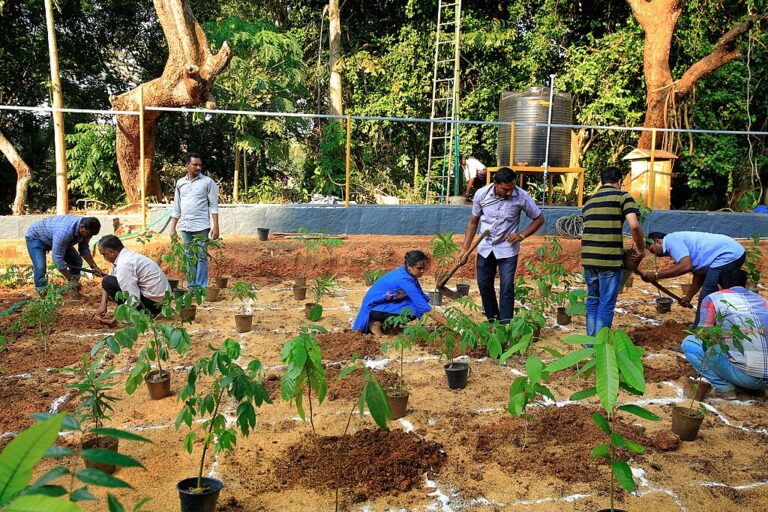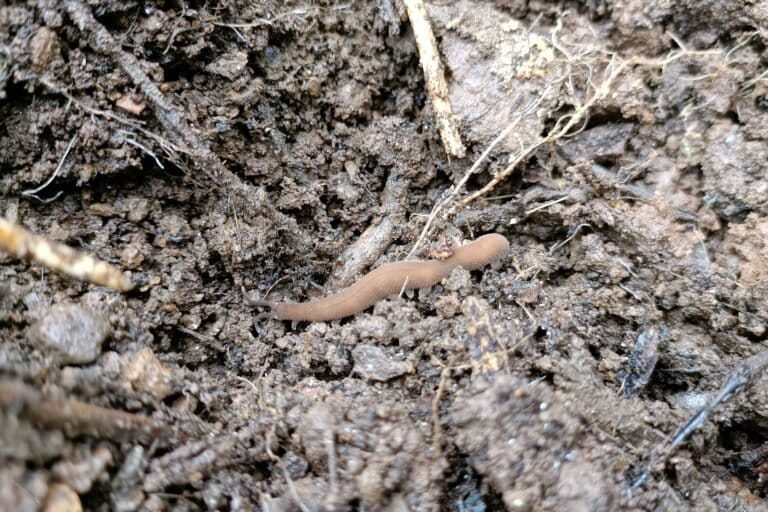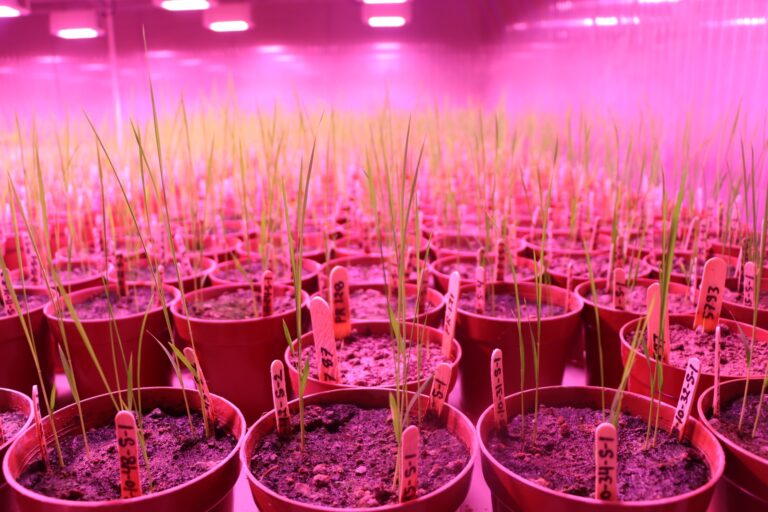- Guggal (Commiphora wightii), a native plant in Gujarat’s Kachchh district has high medicinal value. However, its overexploitation has led it to be declared critically endangered by the IUCN.
- Conservation efforts by researchers and the government went full-swing to save the plant and Local farmers began to grow the guggal—both for economic benefit, as well as for community awareness and involvement in its conservation.
- Mitho Guggal (Commiphora stocksiana), a species from the same family, is also endangered and has high medicinal value, and now awaits similar conservation attention.
“It is just like a human being,” said Mahipatsinh Sodha, a farmer from Gujarat’s Kachchh district, about guggal, a native plant species in the region, which the International Union for Conservation of Nature (IUCN) has termed critically endangered. “Like a person who would not survive once he bleeds out, the guggal does not survive once it loses its resin.”
Much sought after for its medicinal value, it is the guggal’s very property that led to overexploitation and therefore slow disappearance of this plant species. Efforts to reverse its downfall has however now resulted in Commiphora wightii (guggal) being successfully grown by farmers and a gradual rise in population, even as researchers try to script a similar story for another species of the same family, Commiphora stocksiana or the mitho guggal whose resin is known to be even more potent than the former.

A repository of medicinal goodness
The oleo-gum resin tapped from the stem of C. wightii and its other counterpart is used to make an Ayurvedic drug that is highly in demand in the herbal industry. A research study on C. wightii said that the use of this plant in the treatment of diseases occupies an important place in Ayurveda.
From being used as an antiseptic and an anti-inflammatory to reducing blood cholesterol, treating bone fracture, arthritis, rheumatism, skin disorder, urinary problems, even Parkinson’s disease, guggal’s medicinal use is wide and varied. India used to export processed C. wightii resin products to 42 countries, and even as its demand continues to be high, considering its dwindling population, it is now banned for export (IUCN Red List Assessment).
In the Vandai village in Kachchh, a farmer Mhobatsinh Sindhal said that he remembers that about six decades ago, not only was guggal’s oleo-resin used for medicinal purpose, it was also used “like cement” to glue stones together, in order to make walls. “Guggal was present in abundance in the wild then, and there would be a lot of tapping of its stems,” he told Mongabay-India. “In the 1960s, the plant’s oleo-resin would sell for Rs. 2.5 per kilogram and outsiders would frequent their village to procure it. Over time, the price rose to exceed Rs. 2,000 for one kilogram of resin.” On his father’s insistence, Sindhal however took it upon himself to convince the villagers to stop tapping the plants in their area.
The downfall and efforts to reverse the process
Even then, the wild population of C. wightii continued to decline and in 2015, IUCN categorised it as critically endangered. “Over the past 84 years (three generation length) there has been a decline of more than 80 per cent in the wild population as a result of habitat loss and degradation, coupled with unregulated harvesting and tapping of oleo gum resin,” the IUCN Red List Assessment of the plant species said.
This alarmed conservationists. Vijay Kumar, director of the Gujarat Institute of Desert Ecology (GUIDE), said that with the plant’s enormous decline, the government began conservation efforts. “In 2013-2014, we started growing guggal in our nursery, and between 2015 and 2017, we began planting its saplings in the State Medicinal Board Garden in Reladi, Kachchh,” Kumar told Mongabay-India.

Yuvrajsinh Zala, deputy conservator of forests (DCF), Kachchh, said that under a project by the National Medicinal Plants Board, the forest division began a guggal plantation drive in 2018. “In 2018-2019, we planted C. wightii in 250 hectares; in 2019-2020 in 1,000 hectares, and in 2022-2023 in 300 hectares,” he said. “In 2023-2024, too, we will plant it in 300 hectares.”
Two lakh plant saplings of C. wightii were also distributed among 178 beneficiaries, mostly farmers, in 2020-2021 under a project of the Gujarat Medicinal Plants Board. This involved the community in their native plant’s conservation efforts. Farmers were made aware of the importance of conserving this plant species, the threats of overexploitation and how, considering its medicinal value, it could provide them with a great economic boost.
Mahipatsinh has, until now, raised three lakh saplings of C. wightii. “You can plant these saplings even in the wasteland and it will thrive because it is native to this place,” he said, “The only thing is that you have to wait at least seven-eight years before you tap its resin.” This long waiting period, he said, discouraged some of the farmers to grow it on the land—“you can harvest mango after four years, but in this case it takes double the time.” And even then the amount of resin that can be tapped will not exceed 250-300 grams. Plus, the plant would die once its resin is tapped.
“So, I grow new saplings of guggal every year. This way, I will be able to harvest every year once the plants mature,” he said.
Mhobatsinh, on the other hand, has been growing C. wightii along the periphery of his 120 acres farmland. Since it is a shrub, it makes for a good fence. “I have sold the seed of guggal, but have not tapped the resin, nor do I want to do it now—my aim has always been to conserve the plant. During the monsoon, the birds eat the fruit and help in seed dispersal,” he said. “The seeds of guggal would sell for Rs. 4,000 per kilogram.”
Kumar of GUIDE said that they have planted 70,000 saplings of C. wightii in the medicinal plant board garden and 2,500 saplings of C. stocksiana—listed as endangered by IUCN—which has been further propagated with cuttings.
The lesser-known cousin awaits similar success
Researcher Rohit Patel who found only three saplings of C. stocksiana or the mitho guggal in the Zara-Zumara hills in Kachchh back in 2008—“at a time when even the Botanical Survey of India was unaware of it being found in this area”—said that while the population of C. wightii is growing, equal focus must be given on its counterpart for similar results. “It was only when I went through old references that I found that C. stocksiana was reported from this area,” Patel said. “Thereon, I explored this plant species for my PhD and scanned the area in monsoons, because it is during this period when the leaves of C. stocksiana and C. wightii can be seen clearly and differentiated. I also found a traditional healer in Lakhpat who had this plant species.”
C. stocksiana is found only in the Kachchh region of Gujarat in India and like C. wightii, its oleo gum resin has high medicinal value. Traditional healers say that mitho guggal was traded to other parts of the country in earlier times because of its properties but because of overexploitation, began facing the threat of extinction.
In 2014-2015, Patel approached the Gujarat Biodiversity Board to push for conservation efforts of C. stocksiana and helped raise almost 5,000 saplings.
The road ahead
A significant move in the conservation of these plant species, said Kumar, has been an experiment by the University of Trans-Disciplinary Health Sciences and Technology (TDU), Karnataka with GUIDE to develop a tapping technique, such that the plant does not perish after its resin has been tapped. “We have had success in this experiment,” he added. “The plant has been able to survive even after two tappings—once in summer and once in winter—in a year. However, we may need some more time [for more research].”

Mahipatsinh, who served in the state forest department before retiring and becoming a farmer, added that if a limited amount of resin, “around 200-300 grams” is tapped from a mature plant of 10 years, it would probably survive for two-three years. “I speak from experience and will try on my plants once they attain maturity,” he said.
Read more: Himalayan medicinal plants under threat due to climate change
Banner image: Farmer Mhobatsinh Sindhal stands beside the C. wightii (guggal) fence in his farm. Photo by Azera Parveen Rahman.














